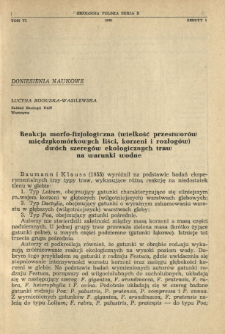- Search in all Repository
- Literature and maps
- Archeology
- Mills database
- Natural sciences
Advanced search
Advanced search
Advanced search
Advanced search
Advanced search

Object
Title: Reakcja morfo-fizjologiczna (wielkość przestworów międzykomórkowych liści, korzeni i rozłogów) dwóch szeregów ekologicznych traw na warunki wodne
Subtitle:
Reakcja morfo-fizjologiczna na warunki wodne ; Morpho-physiological reaction (size of intercellular spaces in leaves, roots and rhizomes) of two ecological ranges of grasses to water conditions
Contributor:
Polska Akademia Nauk. Komitet Ekologiczny
Publisher:
Place of publishing:
Description:
Pages 25-33 ; 24 cm ; Bibliographical references (page 32) ; Abstract in English
Type of object:
Abstract:
Tests were carried out with regard to the size of intercellular spaces both in leaves and in the underground parts of plants on severa! species of the. genus Festuca and Poa.Range I: F. gigantea -F. arundinacea -F. pratensis -F. rubra -F. heterophylla -F. ovina.Range II: P. palustris -P. pratensis -P. compressa -P. annua. This work forms to a certain degree the supplement of B a u m a n n and K l a u s s' researches (1955), and its aim was to determine whether the capacity for growth of roots in a given well determined level of soil moisture for several species of grasses (at identical of high moisture soil conditionsl has any connection with the size of aerial system of the given species. Cultures of above species were carried out in experirnental vases in which the distance of water surface from surface of soil amounted to 30-40 cm. The size of intercellular spaces in leaves, roots and underground rhizomes was tested by means of the vacuum-filtration method and calculated in proportion to the volume of given organ .It was established that ranging of the tested species from genus Festuca and Poa finds its motivation in the morpho-physiological reaction of the particular species -namely in the capacity for creating a convenient intercellular spaces system. In the range of the genus Festuca the decrease in the general size of intercellular spaces between extreme species is 1,8 times than in the range Poa.The difference at the size of spaces between extreme species in the range, proves to be nearly two times greater for the underground parts than for leaves. It proves that the reaction of underground parts of plants is stronger than that of parts above ground (leaves). On basis of her present and previous works the author states that all species of grasses submitted to testing are characterised by the highest percentage of intercellular spaces in leaves, a lower one in roots and principally the lowest one in rhizomes. The author points out that the „coefficient" of the relation of plant to soil aeration i. e. the so called „size of intercellular spaces" - can be useful in research work analysing the relation of plants to their surroundings.
Relation:
Volume:
Issue:
Start page:
End page:
Detailed Resource Type:
Resource Identifier:
oai:rcin.org.pl:120500 ; ISSN 0424-7205
Source:
MiIZ PAN, call no. P.3259 ; click here to follow the link
Language:
Language of abstract:
Rights:
Creative Commons Attribution BY 3.0 PL license
Terms of use:
Copyright-protected material. [CC BY 3.0 PL] May be used within the scope specified in Creative Commons Attribution BY 3.0 PL license, full text available at: ; -
Digitizing institution:
Museum and Institute of Zoology of the Polish Academy of Sciences
Original in:
Library of the Museum and Institute of Zoology of the Polish Academy of Sciences
Projects co-financed by:
Access:
Object collections:
- Digital Repository of Scientific Institutes > Partners' collections > Museum and Institute of Zoology PAS > Scientific Journals
- Digital Repository of Scientific Institutes > Literature > Journals/Articles
Last modified:
Feb 4, 2022
In our library since:
Apr 14, 2020
Number of object content downloads / hits:
52
All available object's versions:
https://rcin.org.pl./publication/98138
Show description in RDF format:
Show description in RDFa format:
Show description in OAI-PMH format:
Objects Similar
Roguska-Wasilewska, Lucyna
Skoracka, Anna Pacyna, Anna
Skoracka, Anna Lewandowski, Mariusz Boczek, Jan
Breymeyer, Alicja
Huflejt, Tomasz
Protective resemblance borne by certain African insects to the blackened areas caused by Grass Fires
Poulton, Edward Bagnall (1856–1943)

 INSTYTUT ARCHEOLOGII I ETNOLOGII POLSKIEJ AKADEMII NAUK
INSTYTUT ARCHEOLOGII I ETNOLOGII POLSKIEJ AKADEMII NAUK
 INSTYTUT BADAŃ LITERACKICH POLSKIEJ AKADEMII NAUK
INSTYTUT BADAŃ LITERACKICH POLSKIEJ AKADEMII NAUK
 INSTYTUT BADAWCZY LEŚNICTWA
INSTYTUT BADAWCZY LEŚNICTWA
 INSTYTUT BIOLOGII DOŚWIADCZALNEJ IM. MARCELEGO NENCKIEGO POLSKIEJ AKADEMII NAUK
INSTYTUT BIOLOGII DOŚWIADCZALNEJ IM. MARCELEGO NENCKIEGO POLSKIEJ AKADEMII NAUK
 INSTYTUT BIOLOGII SSAKÓW POLSKIEJ AKADEMII NAUK
INSTYTUT BIOLOGII SSAKÓW POLSKIEJ AKADEMII NAUK
 INSTYTUT CHEMII FIZYCZNEJ PAN
INSTYTUT CHEMII FIZYCZNEJ PAN
 INSTYTUT CHEMII ORGANICZNEJ PAN
INSTYTUT CHEMII ORGANICZNEJ PAN
 INSTYTUT FILOZOFII I SOCJOLOGII PAN
INSTYTUT FILOZOFII I SOCJOLOGII PAN
 INSTYTUT GEOGRAFII I PRZESTRZENNEGO ZAGOSPODAROWANIA PAN
INSTYTUT GEOGRAFII I PRZESTRZENNEGO ZAGOSPODAROWANIA PAN
 INSTYTUT HISTORII im. TADEUSZA MANTEUFFLA POLSKIEJ AKADEMII NAUK
INSTYTUT HISTORII im. TADEUSZA MANTEUFFLA POLSKIEJ AKADEMII NAUK
 INSTYTUT JĘZYKA POLSKIEGO POLSKIEJ AKADEMII NAUK
INSTYTUT JĘZYKA POLSKIEGO POLSKIEJ AKADEMII NAUK
 INSTYTUT MATEMATYCZNY PAN
INSTYTUT MATEMATYCZNY PAN
 INSTYTUT MEDYCYNY DOŚWIADCZALNEJ I KLINICZNEJ IM.MIROSŁAWA MOSSAKOWSKIEGO POLSKIEJ AKADEMII NAUK
INSTYTUT MEDYCYNY DOŚWIADCZALNEJ I KLINICZNEJ IM.MIROSŁAWA MOSSAKOWSKIEGO POLSKIEJ AKADEMII NAUK
 INSTYTUT PODSTAWOWYCH PROBLEMÓW TECHNIKI PAN
INSTYTUT PODSTAWOWYCH PROBLEMÓW TECHNIKI PAN
 INSTYTUT SLAWISTYKI PAN
INSTYTUT SLAWISTYKI PAN
 SIEĆ BADAWCZA ŁUKASIEWICZ - INSTYTUT TECHNOLOGII MATERIAŁÓW ELEKTRONICZNYCH
SIEĆ BADAWCZA ŁUKASIEWICZ - INSTYTUT TECHNOLOGII MATERIAŁÓW ELEKTRONICZNYCH
 MUZEUM I INSTYTUT ZOOLOGII POLSKIEJ AKADEMII NAUK
MUZEUM I INSTYTUT ZOOLOGII POLSKIEJ AKADEMII NAUK
 INSTYTUT BADAŃ SYSTEMOWYCH PAN
INSTYTUT BADAŃ SYSTEMOWYCH PAN
 INSTYTUT BOTANIKI IM. WŁADYSŁAWA SZAFERA POLSKIEJ AKADEMII NAUK
INSTYTUT BOTANIKI IM. WŁADYSŁAWA SZAFERA POLSKIEJ AKADEMII NAUK


































